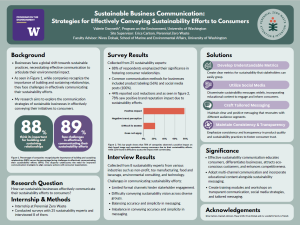Sustainable Business Communication: Strategies for Effectively Conveying Sustainability Efforts to Consumers
In today’s global landscape, there is a growing emphasis on sustainable practices, prompting businesses to articulate and measure their environmental and social impact. Effective communication of sustainability efforts is crucial for businesses to bridge the gap between intention and execution, fostering consumer understanding and commitment to sustainable practices. This paper explores the communication strategies employed by sustainable businesses to effectively convey their sustainability initiatives to consumers. I executed a combination of research methods, including surveys, interviews, and market research. This allowed me to gather insights from sustainability professionals and businesses with sustainable business models. The findings highlight the importance of sustainable practices for consumer relationships, the challenges faced in communicating sustainability efforts, common methods of communication, and the impact of sustainability initiatives on cost reduction, brand reputation, and competitiveness. Challenges identified include limitations in formal communication channels, difficulty quantifying sustainability outcomes, and maintaining consistency in messaging. However, various approaches have emerged to overcome these challenges, including the development of easily understandable metrics, the utilization of visual aids and training programs, and leveraging social media platforms. The implications of effective sustainability communication extend beyond enhancing consumer perceptions to fostering sustainability education, increasing opportunities for businesses, and informing messaging strategies. Overall, this paper contributes to the understanding of sustainability communication and provides insights for businesses aiming to navigate the complexities of communicating sustainability efforts in a rapidly evolving consumer landscape.
